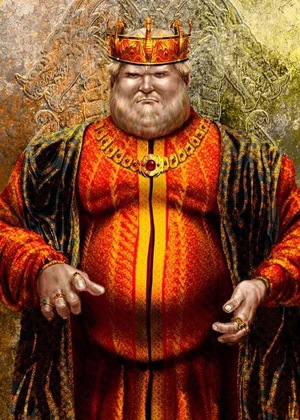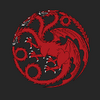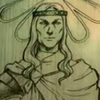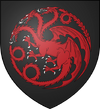
|
SPOILER WARNING
This page includes content relating to the Dance of the Dragons, and therefore contains potential spoilers for future seasons of House of the Dragon, as revealed in George R.R. Martin's writings. Anyone wishing to remain completely spoiler free for this prequel series should avoid any pages displaying this tag. |
- "Aegon the Unworthy legitimized all his bastards on his deathbed. Inevitably the greatest of these, Daemon Blackfyre, declared himself the rightful heir, and ignited yet another war for the crown."
- ―Varys
Aegon IV Targaryen,[b] also called Aegon the Unworthy, was the eleventh king of the Targaryen dynasty to rule the Seven Kingdoms. He was known for his endless gluttony, and even better known for legitimizing all of his bastards on his deathbed, eventually leading to the Blackfyre Rebellion.
Biography[]
Background[]
He succeeded his father Viserys II Targaryen and was, in time, succeeded by his sole trueborn son Daeron II. Aegon IV fathered several children, both trueborn and bastard. He was the father of Daeron and Daenerys by his sister-wife, Queen Naerys and with his cousin and mistress, Queen Daena, he fathered Daemon Blackfyre.[citation needed]
On his deathbed, Aegon IV legitimized all his bastard children, leading Daemon Blackfyre to declare himself the rightful heir to the Iron Throne and igniting another war for the crown.[6][2] Daemon's descendants in House Blackfyre would continue to revolt for almost a century afterwards, and the Blackfyre Rebellion would finally end when the rogue Targaryen cadet branch was rendered extinct in the War of the Ninepenny Kings.[citation needed]
Game of Thrones: Season 1[]
Aegon IV (along with his vast progeny) is mentioned in the House Targaryen entry of the book The Lineages and Histories of the Great Houses of the Seven Kingdoms. The entry notes that he became king in his thirty-seventh year, after the death of his father.[7]
Game of Thrones: Season 4[]
Tyrion Lannister mentions that Aegon the Unworthy is one of the kings analyzed in the classic book, The Lives of Four Kings.[8]
Quotes[]
Spoken about Aegon[]
- "The Lives of Four Kings. Grand Maester Kaeth's history of the reigns of Daeron the Young Dragon, Baelor the Blessed, Aegon the Unworthy, and Daeron the Good. A book every king should read."
- ―Tyrion Lannister
Family[]
|
Aegon III Targaryen Deceased |
Daenaera Velaryon[c] Deceased |
Viserys II Targaryen Deceased |
Larra Rogare[c] Deceased | ||||||||||||||||||||||||||||||||||||||||||||||||||||||||||||||||||||||||||
|
Daeron I Targaryen Deceased |
Baelor I Targaryen Deceased |
Elaena Targaryen |
Rhaena Targaryen Deceased |
Daena Targaryen Deceased |
Aegon IV Targaryen Deceased |
Naerys Targaryen Deceased |
Aemon Targaryen Deceased | ||||||||||||||||||||||||||||||||||||||||||||||||||||||||||||||||||||||
|
Daemon Blackfyre Deceased |
Rohanne of Tyrosh |
Aegor Rivers |
Brynden Rivers |
Shiera Seastar |
Daeron II Targaryen |
Myriah Martell Deceased |
Maron Martell |
Daenerys Targaryen | |||||||||||||||||||||||||||||||||||||||||||||||||||||||||||||||||||||
In the books[]

Aegon IV Targaryen by Roman "Amok" Papsuev.©
In the A Song of Ice and Fire novels, Aegon IV is remembered as one of the worst Targaryen kings in the entire history of the Targaryen dynasty, which is the reason why he is popularly known as "Aegon the Unworthy." Aegon was a decadent, gluttonous, and corrupt ruler, who indulged his passions and whims at every opportunity. During his reign, he wore a huge and heavy red gold crown, whose points are dragon heads with gemstone eyes.
Being handsome and attractive in his youth, Aegon had an incredible wit as a young prince and is popular with women, both highborn and lowborn. He had as many as nine mistresses and many bastards. Supposedly, he had any woman he wanted, whether they were married or not. However, the only woman he doesn't love is Naerys Targaryen, his sister-wife, as she was gentle, pious, and frail, which was what Aegon hates. People often joked that while the Targaryen words were "Fire and Blood," Aegon IV's motto might as well have been "Wash her and bring her to my bed."
Due to his years of overindulgence, by the end of his reign, Aegon IV was extremely obese, to the point that his legs could barely support his own weight. Even so, he remained quite vain throughout his life. Moreover, he was a very petty man, needlessly causing strife at the royal court and in his own family, including his own true-born son Daeron. Four of King Aegon's bastard children were born to noblewomen, and they became known as the "Great Bastards." Chief among them was Daemon Blackfyre, who, upon being legitimized, created House Blackfyre. Other notable bastards were Aegor Rivers ("Bittersteel"), Brynden Rivers ("Bloodraven"), and Shiera Seastar. Aegon IV foolishly legitimized all of his bastard children upon his deathbed, which resulted in Daemon Blackfyre, rumored to be Aegon's favorite child despite being a bastard, declaring himself the rightful heir and tearing apart the Seven Kingdoms in a civil war. Ultimately, Aegon IV's corruption led to a series of Blackfyre Rebellions, which would plague Westeros for five generations.
In A Storm of Swords, Robb tells Catelyn he decided to legitimize Jon and name him as his successor. Catelyn, resentful toward Jon as ever, bitterly responds "Aegon the Fourth legitimized all his bastards on his deathbed. And how much pain, grief, war, and murder grew from that?" Robb, fully trusting Jon, dismisses his mother's objection and issues a royal decree according to his decision.[9]
According to author George R.R. Martin, Aegon IV is loosely the Targaryen equivalent of King Henry VIII of England.[10] Martin's instructions for artistic depictions of Aegon IV explicitly cite Henry VIII. Both kings started out young and attractive, but by the ends of their reigns became infamously fat from overindulgence. Moreover, they had numerous sexual affairs, which resulted in bloody succession conflicts, which were eventually resolved with the rise of good rulers (Daeron II and Elizabeth I respectively).
Appearances[]
 – "Cripples, Bastards, and Broken Things" (mentioned in text)
– "Cripples, Bastards, and Broken Things" (mentioned in text) – "A Golden Crown" (mentioned in text)
– "A Golden Crown" (mentioned in text) – "Two Swords" (mentioned in text)
– "Two Swords" (mentioned in text) – "The Lion and the Rose" (mentioned)
– "The Lion and the Rose" (mentioned) – "The Bastards of Westeros" (mentioned)
– "The Bastards of Westeros" (mentioned) – "The Kingsguard - Jaime Lannister" (mentioned)
– "The Kingsguard - Jaime Lannister" (mentioned) – "The Kingsguard - Bronn" (mentioned)
– "The Kingsguard - Bronn" (mentioned) – "The Death of Kings" (mentioned)
– "The Death of Kings" (mentioned) – "The Golden Company" (mentioned)
– "The Golden Company" (mentioned) – "The Last Dragons" (illustrated)
– "The Last Dragons" (illustrated) – "The Blackfyres" (illustrated)
– "The Blackfyres" (illustrated)
References[]
- ↑ 1.0 1.1 1.2 1.3 1.4 1.5 Game of Thrones: Season 1, Episode 6: "A Golden Crown" (2011).
- ↑ 2.0 2.1 2.2 Histories & Lore: Season 4, Short 14: "The Death of Kings" (2015).
- ↑ 3.0 3.1 3.2 3.3 3.4 Histories & Lore: Season 8, Short 3: "The Blackfyres" (2019).
- ↑ Histories & Lore: Season 4, Short 12: "The Kingsguard - Bronn" (2015).
- ↑ Histories & Lore: Season 4, Short 1: "House Martell" (2015).
- ↑ Histories & Lore: Season 4, Short 5: "The Bastards of Westeros" (2015).
- ↑ Game of Thrones: Season 1, Episode 4: "Cripples, Bastards, and Broken Things" (2011).
- ↑ Game of Thrones: Season 4, Episode 2: "The Lion and the Rose" (2014).
- ↑ A Storm of Swords, Chapter 45, Catelyn V (2000).
- ↑ So Spake Martin, November 1, 2005
Notes[]
- ↑ Conjecture based on information from Fire & Blood; may be subject to change.
- ↑ High Valyrian: Āegon IV Targārien
- ↑ 3.0 3.1 Conjecture based on information from The World of Ice & Fire; may be subject to change.
External links[]
| Titles |
King of the Andals and the Rhoynar and the First Men · Lord of the Seven Kingdoms · Protector of the Realm · Protector of the Seven Kingdoms |
| Targaryen dynasty |
Aegon I (1–?) · Aenys I · Maegor I (?–48) · Jaehaerys I (48–103) · Viserys I (103–132) · Aegon II (132–?) · Aegon III · Daeron I · Baelor I · Viserys II (?–172) · Aegon IV (172–184) · Daeron II (184–209) · Aerys I (209–?) · Maekar I · Aegon V (?–258) · Aerys II (258–281) |
| Baratheon dynasty |
Robert I (281–298) · Joffrey I (298–301) · Tommen I (301–303) |
| Post-War of the Five Kings |
Cersei I (303–305) · Daenerys I (305) |
| Elected monarchs (Six Kingdoms) |
Bran I (305–present) |























